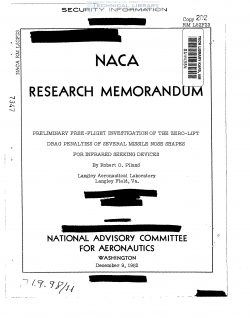naca-rm-l52f23
- Version
- 87 Downloads
- 616.02 KB File Size
- 1 File Count
- May 31, 2017 Create Date
- May 31, 2017 Last Updated
National Advisory Committee for Aeronautics, Research Memorandum - Preliminary Free Flight Investigation of the Zero Lift Drag Penalties of Several Missile Nose Shapes for Infrared Seeking Devices

The initial results of an investigation to study nose shapes con-
sidered suitable for housing an infrared seeker are presented. The
zero-lift drag characteristics of a missile—like body with various
unconventional nose shapes were obtained through a range of Mach num—
bers from O. 8 to l. 8 and Reynolds numbers, based on body length, from
20 X 106 to 70 x 106, respectively, by using rocket—propelled free-
flight models. Results of the tests indicate that at supersonic speeds
about 70 percent of the drag penalty incurred by using a spherical tip
nose shape may be eliminated by using nose shapes which, it is believed,
will still allow the seeker to function.
Of the nose shapes tested, a 300 cone incurred the smallest drag ,5
penalty at supersonic speeds when compared with parabolic nose shape
of higher fineness ratio. Of those nose shapes,which could possibly
be constructed entirely of metal or of a transparent material, the dif-
ferences in drag were negligible.
In the present development of guidance systems for missiles, a
seeker device, sensitive to infrared radiation, as described in refer~
ence l, is being considered. A seeker of this type utilizes a lens,
the preferable location of which is the nose of the missile. If the
lens is located in the nose of the missile, however, the use of a low—
drag parabolic or conical nose shape of high fineness ratio may be
practical because of aberrations and a high percentage of reflections.
On the other hand, using the rather blunt lens or a spherical tip for a
nose shape results in extreme drag penalties at Mach numbers above
about l.# as indicated in reference 2. The problem, therefore, resolves
into one of determining a nose shape which will allow the seeker to
operate but will not incur an intolerable drag penalty. Many nose
shapes have been suggested by various sources as possible solutions to
the problem. The possibilities of using plain spikes ahead of blunt
bodies for drag reductiOn have been reported in references 3 and h. The
present investigation undertakes to assay the drag penalties which
would be incurred by the use of several other suggested noses. The nose
shapes were flight-tested on a fin~stabilized missile-like body.
The models were rocket-propelled to a Mach number of 1.8. During the
following coasting period, zero-lift drag data were obtained. The
Reynolds number, based on body length, varied from 20 x 106 to 70 x 106
for mach numbers from 0.8 to 1.8, respectively. Tests were conducted
at the Pilotless Aircraft Research Station at Wallops Island, Va.
| File | Action |
|---|---|
| naca-rm-l52f23 Preliminary Free Flight Investigation of the Zero Lift Drag Penalties of Several Missile Nose Shapes for Infrared Seeking Devices.pdf | Download |

Comment On This Post